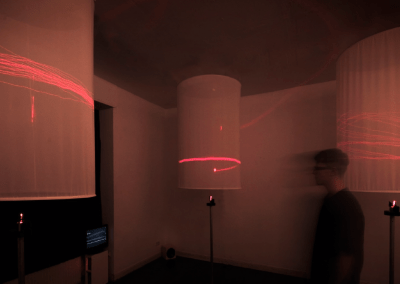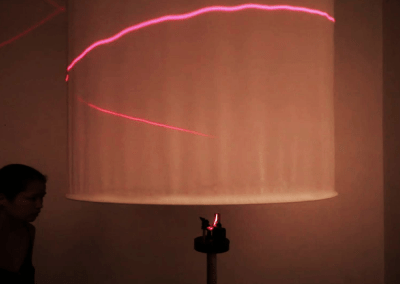
GW170817 SPECULUM
By Ephemeral Tomorrow (Riccardo Torresi, Maxime Lethelier, Asako Fujimoto) | Professional (International category)
“Technology has always played a big role in art history. When press and photography were invented they also changed the way we deal with information and its circulation. Digitalization in a way is similar: it also affects information distribution but not its content. The main difference is that digital content is not always directly connected with materiality or physical presence, in that sense, the matter behind art also get enriched with new concepts and ideas that would never be achieved before.”
~ Ephemeral Tomorrow
In 1915, when publishing his General Theory of Relativity, Einstein changed the world conception and opened the door to an infinity of new possibilities by arguing that gravity is the product of mass bending space and time. Therefore, when powerful masses in space are set in motion, this causes waves in space-time, which rush through the cosmos at the speed of light and deform all objects on their way, according to their distances. For forty years, astrophysicists tried unsuccessfully to prove the existence of gravitational waves, which until then had only been assumed theoretically. But even if this theory stayed purely hypothetical, it was used as the theoretical basis for astrophysical research. This situation is very common in physics theories are put forward that yet have to be proved or refuted. In this process, theoretical assumption and valid proof, genuineness and speculation are constantly competing.
Most of the times this concerns cosmic events, which are only perceptible to humans through the use of advanced technical instruments. Only three years ago the existence of gravitational waves was finally proven, with the help of super-detectors at the Laser Interferometer Gravitational-Wave Observatory (LIGO) in Louisiana and Washington. LIGO was able to measure the otherwise barely noticeable changes caused by these astronomical events. In 2017 the scientists Rainer Weiss, Kip Thorne and Barry Barish were rewarded with the Nobel Prize in Physics for their role in detecting gravitational waves.
Speculum, the Latin word for mirror, is the root of the verb speculate, which used to mean looking at the stars, and also speculation, the forming of a theory or conjecture without firm evidence. GW170817 SPECULUM seeks to investigate, as well as speculate, about a particular event: the recording of gravitational waves produced by the merging of two neutron stars on August 17th 2017 by the LIGO Hanford, LIGO Livingston and Virgo detectors (also known as GW170817).
In the installation, laser beams are reflected by rotating mirrors onto a cylindrical fabric, creating waves according to the event’s data recorded in each one of the 3 detectors. Gravitational waves moving through time and space, which were transformed into measurable data sets, are translated back into sound and light in motion, through the same means used to detect them. The generated visuals behave differently than the original gravitational waves, yet they are able to show this cosmic phenomenon in a more perceivable way.
Location
ADM Gallery 2
About the Artist
Within their conceptional approach, the members of artist collective Ephemeral Tomorrow combine technical knowledge with clean, minimalistic aesthetics and present both in their data relevant audiovisual installations. Established in 2016, Riccardo Torresi, Maxime Lethelier, Asako Fujimoto participated in several group shows in Austria, Italy and Germany.
Riccardo Torresi is a media artist, architect and film maker from Italy. His works were exhibited in various museums and festivals such as HKW Berlin, British HCI Conference and Berlin Festival of Lights between others. His research project “Au Fil du Fleuve” was nominated for the 1st prize at the “International Architectural Thesis Award” and the “Archiprix Italia” 2013 other than being published in various architecture and design magazines. His more recent work “Relative Space” received an honorary mention at the Share Prize 2017 in Turin (Italy).
Maxime Lethelier is a french media artist interested in interactive installations and visuals for music. He collaborated with the award winning collective Hehe (Golden Nica 2008 Hybrid Art). He also works with theatre companies developing stage design involving new technologies (“Hiver” and “Kant” by Ex Voto A
la Lune, “Supermarket” by Le Joli Collectif…) and is involved in the creation of interactive video installations. His works focused essentially on public or shared space, and how people interact with their environment.
Asako Fujimoto is an electronic music composer/performer originally from Japan and based in Berlin. She works with analog and digital synthesizers for media installations. In 2005, she started to work on sound design for the video artist, Katja Loher, after moving to Europe in 2010, she continues working on sounds for new medias as well as theatre and film collaborations.






